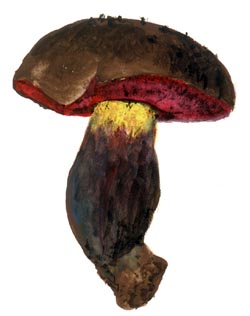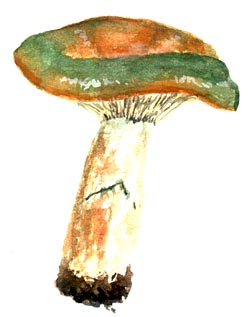

I've been a sketcher for as long as I can remember. I drew cartoons for my high school yearbook and for various periodicals after that. When bored or unoccupied, I sketched things in my immediate environment on whatever surface was available—a restaurant napkin, a styrofoam cup, or the blank side of a loose-leaf page. There had been a series of drawings of my left hand -- open, closed, viewed from above, below, and from the side, with fingers extended and retracted. There was a folio of drawings of the furniture in my apartment- a wicker chair drawn from different angles, a couch on which I did all my reading, the lamp and refrigerator, and the telephone and typewriter in a shared office. Later Barbara and I began sketching on trips as mnemonics (memory-aids). We saw more and remembered more when we drew things.

Some of these early drawings, completed before we joined MSSF, included fungi described only as "Mushrooms on stump" or "Mushrooms in forest." All this changed following our acquisition of a mushroom field guide and our first fungus fair. The field guide was Lange and Hora's A guide to mushrooms and toadstools. This wasn't the most appropriate book for Northern California as it was originally published in Denmark as Illusteret Swampeflora. The species illustrated and their names often did not correspond to those we found. Later we acquired Arora's Mushrooms Demystified whose readable prose buoyed by the author's fine sense of humor described Northern California fungi. Barbara began a journal record of unidentified specimens, which included text descriptions and field drawings. We carried this journal to the Fungus Fair and checked out the displays and consulted the resident experts. In those days the experts stood nine feet tall, with prodigious knowledge of Latin names, staining and bruising qualities, mycorrhyzal associations (You found this under a pine tree, didn't you?" "Amazing! How did you know that?").
While Barbara continued her journal entries, I started doing water color paintings of fungi on 8x10 Strathmore pads. The paper was inexpensive and I liked the medium grade (400-3), whose texture lay somewhere between smooth and rough. I work quickly; painting a large fungus in 15-20 minutes, an LBM (Little Brown Mushroom) in 5 minutes. The rule is to paint first, while the mushroom is still fresh-looking, and identify later after obtaining a spore print. Paintings were done from actual fungi collected by us or others on a foray. The locations given are approximate, often referring to the known place nearest to the forest where the mushroom was collected.
It is easy to explain why I started painting mushrooms. They were available, interesting, and they didn't move. I paint most things with these characteristics. I have separate binders of water colors of peaches, pears, plums, eggplant, peppers (more than 50 varieties), acorns, toys, and wildflowers, plus scenes from trips Barbara and I have taken. It was only natural that I should paint the fruits of a shared hobby.
Following the tradition of botanical illustration, I paint fungi surrounded by white space rather than as they appear in the forest growing amidst plants, grasses, rocks, and snails. The only exceptions are tree fungi that I often paint attached to wood, and congregate fungi like Collybia growing in clusters. I also include pieces of leaf or grass on a viscid cap. Other than that, the mushroom floats in white space. Cathy Johnson, author of The Sierra Club Guide to Sketching in Nature, explains the basis of this presentation method:
When I am doing a botanical sketch, I don't try to show background - any of the things that might appear in a more conventional flower portrait. This is not a painting or drawing, per se, but a botanical, a study of a single plant and its habits. (p. 169)
Identification was done from macroscopic features as described in field guides. When we took part in organized forays or attended a fungus fair, we obtained expert opinion from David Arora, Gary Lincoff, Harry Thiers, Darvin DeShazer, Rolf Singer, Jean Love, Greg Mueller, Gaston Guzman, and Florencia Ramirez-Guillen. When the identification was made or confirmed by someone else, this is indicated on the reverse side of the painting. These helpful folks are not responsible for labeling errors; I bear full responsibility.

A few years ago, the Davis Campus hired two trained mycologists. Professor Dave Rizzo in the Department of Plant Pathology is most knowledgeable about tree fungi and has been studying Sudden Oak Death in California forests. His associate, Cooperative Extension Specialist Dr. R. Michael (Mike) Davis, assists Dave on projects and also has personal interests in amateur mycology. Mike started the Davis Mycological Society to which Barbara and I belong. Now when we find a fungus beyond our powers of identification, we send it to Mike for DNA sequencing. As a result, the recent identifications on these paintings are more precise and valid than the early ones.
At the outset, the paintings were made with no larger purpose in mind. I found an interesting fungus and I had the time, the materials, and the inclination to paint it. As a researcher, I knew the benefits of standardized and repeatable method. Hence the continued use of the same-size sheets with vertical presentation. Occasionally I painted in smaller or larger pads, and encountered the filing problems associated with odd sized paper. As sketches accumulated, it seemed logical to organize them by genus and place them in loose leaf binders in alphabetical order.
Separate envelopes not included here were used for paintings of unidentified fungi. Some of these were collected in the Sacramento Valley and coastal foothills, which are not well covered in field guides. I suspect a few of the unknowns were actually new varieties, but without full documentation, there was no way to prove this. There are limits to how far one can go relying on macroscopic features. For years, I carried a stack of water colors of unidentified fungi with field notes recorded on the back to the Fungus Fair, in the hopes of finding them on display or obtaining names at the Identification Table. This was helpful in only a few cases and most of these drawings remain unlabelled today. Although Barbara and I became more adept at identifying fungi (by this time we had over 20 field guides on the bookshelf), specimens that were difficult for us were also difficult for the people at the ID table, especially when they were shown a painting rather than an actual fungus.
Many changes in nomenclature and taxonomy occurred during the 30+ years these paintings were made. I saw no reason to re-label older drawings. Erasures and new hand-written labels would be ugly and probably impermanent in the face of further advances in professional mycology. Field guides also become dated upon publication.
Besides sketching mushrooms, I collect them, eat them, write about them as a columnist for Mushroom, The Journal, and have taught classes at UC Davis on The Psychology of Mushrooms. I could not have done this without help from my partner Barbara Sommer, those experts already mentioned, plus members of MSSF such as Larry Stickney, Fred Stevens, and Dennis Desjardin.
– Bob Sommer
– Davis, California
– January 12, 2005